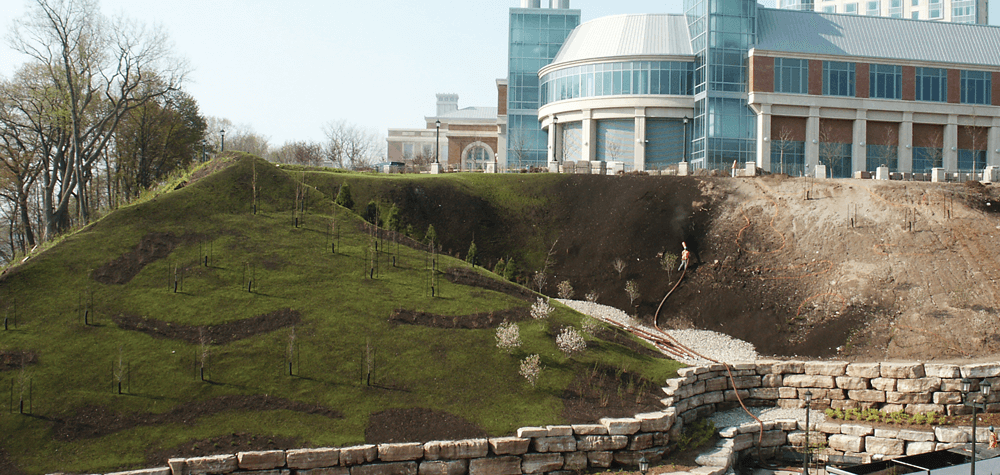September 1, 2011
Organic amendments: Blankets of goodness
BY SEAN JAMESSoil is interesting stuff. It’s not just soil, y’know. That’s just what we can see and feel, mostly. It’s all the life in it that makes it truly fascinating. Obviously there are the worms and insects that turn the soil, but those white threads that we see occasionally — the ‘fairy rings’, the mushrooms, the soil fungi you can see only if you’re looking for them — those are amazing! There are also the bacteria which are constantly breaking down organic matter nature drops on the soil. It’s a whole world down there … and we brutalize it on a regular basis. We remove all the fallen organic matter. We also compact soil with mowers, bobcats (my personal over-used favourite), and foot traffic.
Am I sounding a bit grumpy? I DO try not to do that. Actually I’m starting to see great things regularly, such as homeowners and landscapers amending the soil with regular additions of their own compost, municipal compost or composted pine mulch, aerating the soil, adding mycorrhizal inoculants when planting and more. We are learning … slowly.
Promote beneficial fungi
Of all the soil’s flora and fauna, mycorrhizae are the most important. They steal sugars from plants, but in exchange, they massively increase the plants’ ability to uptake water and nutrients. This improves plants’ ability to feed and cool themselves.
Fungi and beneficial bacteria are the largest part of the nutrient cycle, taking fallen leaves and turning them into basic building blocks the plants use to grow.
One of the easiest and most cost effective ways of applying organic matter is to have compost or composted pine mulch (CPM) blown down. A highly organic mulch, as opposed to wood mulch, does plenty to keep water in, moderate soil temperature, reduce weed growth, make weeding easier and it looks great. It also supports the aforementioned soil micro-ecosystem.
One of the best applications of blown-down mulch is terraseeding.

Slopes like this can be stabilized by blowing a mixture of grass seed and compost-based soil on to the surface.
How cool is that?
Terraseeding does all of the above, but most importantly, it protects the seed during establishment. It’s also a nifty way to apply seed. Several years ago, my company dormant-seeded a lawn with a mix of perennial rye and tall fescue, which is a particularly sun-tolerant mix. Dormant seeding is late fall seeding, intended to germinate in the early spring. Not only did the fescue germinate in one of the driest springs and summers in my memory, it needed no irrigation until mid-July. It was a lesson for me, if ever there was one. Awareness of the process is spreading. According to Andy Crockett of LandSource Organix of Milton, Ont., “The practice of applying native grass and wildflower seed mixes with the terraseeding process has become popular in the last 10 years. The process involves applying the seed and compost-based soil mix in a single application using a blower truck. The seed is computer-calibrated at the target seed rate and is evenly distributed through the growing medium layer — typically, at a 25 mm depth.”
Many seeds are disrupted during establishment by rain or irrigation moving the seed around before it fully roots. Again, Crockett offers, “With native plants, the stability of the organic soil bed allows seed to remain in place until optimal germination conditions occur. Native plants, in particular, favour the warmer soil temperatures consistent with organic soil mixes relative to conventional topsoil. This makes them especially well suited to terraseeding.” Remember, it’s generally not flowing water that causes erosion, but the impact of water droplets.
I’ve said it before and I’ll say it again. The most important thing we can do for our landscapes is to apply organic matter regularly. Composting and terraseeding are the best ways we can do that. They’re easy, and in the long run, they save us money and, occasionally for professionals, make us money. The sub-lesson? Doing good for the environment can be good economics. Everyone wins! Even if one doesn’t believe in ‘green’, perhaps the other green (dollars) can motivate. Either way, it’s good for us as a society and the planet as a whole.
Sean James is owner of an Ontario-based environmentally-conscious landscape design/build/maintenance company. In addition, he is an eco-consultant and a popular speaker. Contact him at s at sdjames@on.aibn.com, or post your thoughts on this column at http://www.fernridgelandscaping.com/forum